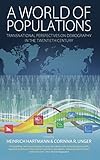A World of Populations : Transnational Perspectives on Demography in the Twentieth Century / ed. by Corinna R. Unger, Heinrich Hartmann.
Material type: TextPublisher: New York ; Oxford : Berghahn Books, [2014]Copyright date: ©2014Description: 1 online resource (264 p.)Content type:
TextPublisher: New York ; Oxford : Berghahn Books, [2014]Copyright date: ©2014Description: 1 online resource (264 p.)Content type: - 9781782384274
- 9781782384281
- 304.60904
- HB851 .W56 2014
- HB851
- online - DeGruyter
| Item type | Current library | Call number | URL | Status | Notes | Barcode | |
|---|---|---|---|---|---|---|---|
 eBook
eBook
|
Biblioteca "Angelicum" Pont. Univ. S.Tommaso d'Aquino Nuvola online | online - DeGruyter (Browse shelf(Opens below)) | Online access | Not for loan (Accesso limitato) | Accesso per gli utenti autorizzati / Access for authorized users | (dgr)9781782384281 |
Frontmatter -- Contents -- List of Figures -- Introduction. Counting, Constructing, and Controlling Populations -- Part I. Producing Demographic Subjects: Transnational Discourses -- 1 The View From Below and the View From Above -- 2 “Reproduction” as a New Demographic Issue in Interwar Poland -- 3 Family Planning—A Rational Choice? -- 4 “Overpopulation” and the Politics of Family Planning in Chile and Peru -- 5 Revisiting the Early 1970s Commoner-Ehrlich Debate about Population and Environment -- Part II. Demographic Knowledge in Practice: Transfers and Transformations -- 6 Counting People -- 7 Laparoscopy as a Technology of Population Control -- 8 A Twofold Discovery of Population -- 9 Seeing Population as a Problem -- 10 Filtering Demography and Biomedical Technologies -- Notes on Contributors -- Index
restricted access online access with authorization star
http://purl.org/coar/access_right/c_16ec
Demographic study and the idea of a “population” was developed and modified over the course of the twentieth century, mirroring the political, social, and cultural situations and aspirations of different societies. This growing field adapted itself to specific policy concerns and was therefore never apolitical, despite the protestations of practitioners that demography was “natural.” Demographics were transformed into public policies that shaped family planning, population growth, medical practice, and environmental conservation. While covering a variety of regions and time periods, the essays in this book share an interest in the transnational dynamics of emerging demographic discourses and practices. Together, they present a global picture of the history of demographic knowledge.
Mode of access: Internet via World Wide Web.
In English.
Description based on online resource; title from PDF title page (publisher's Web site, viewed 25. Jun 2024)


